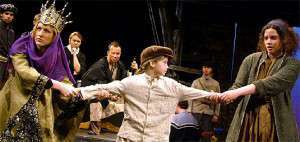by Eric Stroud, dramaturg

Everyone loves to throw around the term "Brechtian". When most people use the term it is in their description of a piece of theatre. Often, they are implying that piece of theatre is non-traditional, and in fact, acknowledges that it is theatre. It has become a sort of blanket statement for all theatre that is different than traditional. However, when people use "Brechtian" in these ways, they are using it incorrectly. What we must understand is that Brecht subscribed to a very specific type of theatre, called Epic Theatre, and then added elements that were unique to his needs and wants for theatre. So what is Epic Theatre?
First and foremost, Epic theatre is a reaction to the 19th century melodrama. It is important to note that though Epic Theatre gained influence from other genres, such as Theatre of the Absurd, Theatre of Cru-elty, Expressionism, and Surrealism, however, it is unique in and of itself. Both Brecht and Constantin Stanislavski (another well know theatre practitioner of the time) used Epic Theatre to make a push back against melodrama when their acting methodologies were devised. Brecht especially did not agree with the shallow, and inflated nature of melodrama, or its simple goal to simply entertain the audience.
However, the practitioners parted ways, as Stanislavski desired his audiences to become submerged in the emotion of a play, Brecht felt that the audience could learn more if they were kept separate from the emotions created on stage. When Brecht began writing and directing, World War II was looming. So, many of his motivations for Epic Theatre spurned from the fact that he wanted people to be engaged politically, both locally and nationally.
This idea of engaging was only possible in Brecht’s mind, were his audience able to think critically about what they were seeing. Should they feel “alienated” from the performance, this meant a job well done for Brecht. This usually meant that the audience was not emotionally involved and therefore able to form real opinions on the subject matter.

Brecht did not believe in an Freytag story structure of play formation, (exposition, rising action, climax, falling action, resolution). Instead his plays can almost be viewed as vignettes of a person’s existence. Not unlike a concert, individual parts of his plays could exist independently of anything else. An example of this can be found in Mother Courage and All Her Children. There are twelve scenes, each holding a different principle or moral that the audience can learn from.
So how did Brecht make Epic Theatre his own?

Brecht used narration in multiple ways. An actor could come out of character and address the audience about how they are feeling. Or stay in character and talk about how the character they are playing is feeling. There could even be a character who is simply there to narrate the entire story.
Ensemble (multi-role playing)
Brecht’s beliefs on the importance of the ensemble shows in the name that he gave his own theatre company, the Berliner Ensemble. He did not believe in a one character, star role, but cared more about equal participation. Brecht would have one actor represent multiple characters, changing back in forth their costumes and dialogue on stage, thus alienating the audience.
Representational Props/ Costume
This is a single item on stage (costume, prop) that represents an en-tire character. Example, a stethoscope represents a doctor, therefore anytime an actor puts it on, they are a doctor. This plays heavily on the previous definition of ensemble.

Discussed without name earlier, placards are literally serve as a means of telling the audience what is currently happening or what is going to happen next. They are literally signs that can be held by actors or even projected.
Spass
Spass means ‘fun’ in German. This was incorporated into Brecht’s performances for two reasons. Firstly, as some audiences were becoming bored during Brecht’s plays, spass was used to liven the atmosphere and even break tensions. Secondly, Brecht realized that when we are laughing, we are also thinking. The BBC gave this great definition of how spass might work,
“It might be used in the form of a comic song, slapstick or physical comedy or even a stand-up routine. For example, a very serious work addressing suicide might break the action at a key moment in a character’s unhappiness to break into a parody of an American advert:
Are you feeling low? Depressed? Think there’s no way out? Then you need new ‘End it All’...
The poor taste of this would be shocking for an audience. But it actually highlights the pain of depression through contrast and black comedy. The audience will laugh and then question why they laughed.”
Historification
“By setting his plays in different countries and time periods, Brecht was able to allegorically make comments about issues in the present. As he had set it in a different time period, the audience were not immediately aware of what the social comment was, meaning he could draw them in before trying to make them question their opinions. In Mother Courage there are also references to other time periods like World War II, despite the fact that the play is taking place during the 30 Years War, in the 1600's.

Tableaux were primarily used by Brecht to emphasize a particular moment of importance. Actors would essentially stand completely still or ’freeze frame,’ in a particular position to get the scene’s meaning across, or allow discussion for the audience.
Dischordant Music
“On a technical level, music is discordant because there is a sense of dissonance where notes do not harmonize. However, with Brecht he would also use this where the atmospheric tone of the song did not match the tone of the scene, making it more effective.”
So the next time you hear someone call something "Brechtian", you can analyze whether or no they are using the word correctly.


